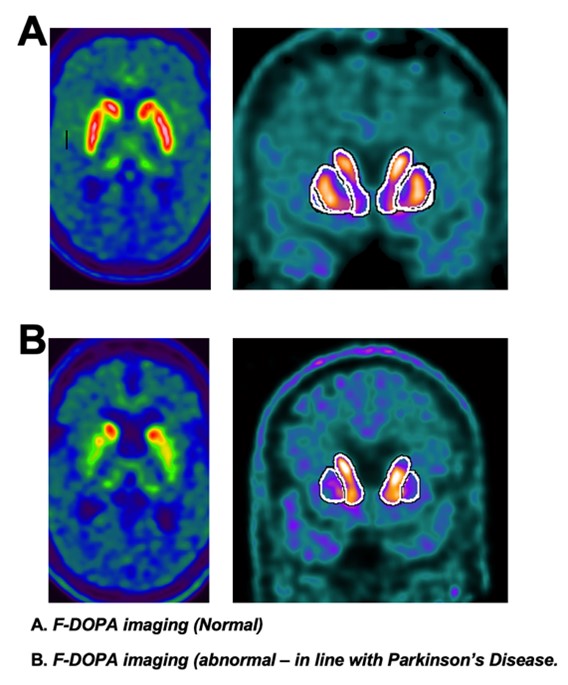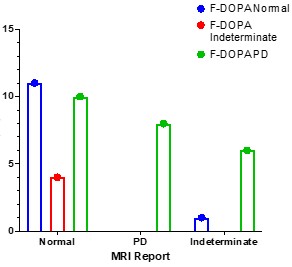Category: Parkinson's Disease: Neuroimaging
Objective: Evaluate the impact of 18F-DOPA PET/CT on clinical management for Parkinsonism.
Background: Parkinson’s Disease affects >100,000 people in Australia with an economic burden of $10 billion AUD/year. Early diagnosis and management can mitigate disease progression. Early differentiation between IPD and atypical parkinsonian syndromes is crucial in dictating subsequent management. However, this is a challenging process as IPD lacks specific biomarkers for diagnosis. 18F-DOPA PET can be used to measure the uptake of dopamine precursors and has shown sensitivity for IPD associated abnormalities prior to clinical onset. This has recently been produced in South Australia and validated to investigate the use of 18F-DOPA PET/CT for Parkinsonism in comparison to standard clinical assessment (Fig.1).
Method: Patients presenting with early, uncertain, or atypical Parkinsonian features were enrolled following specialist referral. A standard protocol for 18F-DOPA PET was used based on EANM guidelines and SNMMI standard procedure for dopaminergic imaging. All F-DOPA PET scans were reported as positive/negative based on putamen uptake, asymmetry, and extent of caudate sparing. The outcomes were compared to existing patient MRI outcomes as relevant. Referrers were asked to dictate any changes to diagnostic confidence/diagnosis/treatment that had occurred as a result of the F-DOPA scans, with outcomes ranging between potentially unrealised – high impact.
Results: Over 300 eligible patients have referred to date, with 215 having completed the scanning process (61% Male, 38% Female, aged 20-88, median=69). The most common diagnosis at the time of referral was undifferentiated Parkinsonism, followed by dystonic tremor, and MSA-P. A significant benefit of FDOPA PET was identified in patients with a preliminary MRI report of normal or inconclusive (Fig.2). Specialist follow-up is ongoing, with early changes in management depending on the extent of diagnostic confidence at time of referral (mild-high impact if confidence <70%, unrealised impact if diagnostic confidence >70% at time of referral).
Conclusion: This is currently the only South Australian model for the use of 18F-DOPA PET/CT for Parkinsonism. Early outcomes are encouraging in terms of clinical value as well as patient outcomes, with potential for the scan to be incorporated into standard practice.
Figure 1 Normal vs Abnormal F-DOPA
Figure 2 MRI report vs F-DOPA PET outcome
To cite this abstract in AMA style:
D. Sharma, M. Nottage, W. Vallat, R. Wilcox, M. Tan, N. Liam, A. Dwyer. Investigating the Use of 18F-DOPA PET/CT to Improve Diagnosis and Clinical Management of Parkinson’s Disease in South Australian Movement Disorder Clinics. [abstract]. Mov Disord. 2024; 39 (suppl 1). https://www.mdsabstracts.org/abstract/investigating-the-use-of-18f-dopa-pet-ct-to-improve-diagnosis-and-clinical-management-of-parkinsons-disease-in-south-australian-movement-disorder-clinics/. Accessed April 2, 2025.« Back to 2024 International Congress
MDS Abstracts - https://www.mdsabstracts.org/abstract/investigating-the-use-of-18f-dopa-pet-ct-to-improve-diagnosis-and-clinical-management-of-parkinsons-disease-in-south-australian-movement-disorder-clinics/


